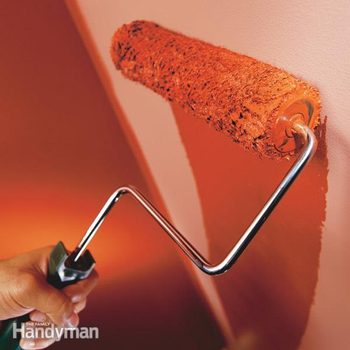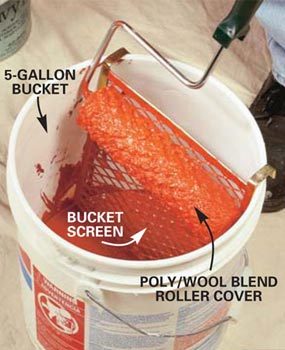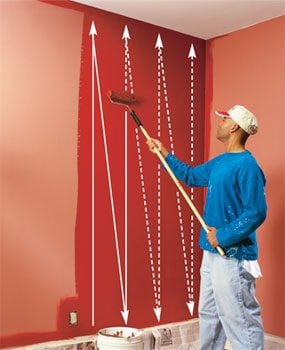Should I Change Rollers For Each Coat Of Paint
Paint Roller Techniques and Tips
Updated: May xix, 2021
Paint faster and smoother with the right rolling techniques

These DIY painting tips will assist y'all roll your walls quickly and smoothly—without leaving roller marks. Nosotros'll show you the tricks and techniques that painting pros use to become a perfectly painted room. All you lot need are some basic tools to paint fast, go cracking results and brand clean upwardly a breeze. Painting is one of the least expensive ways to make over a room, then grab a roller and let's get to piece of work.
You might also like: TBD
- Time
- Complexity
- Toll
- A full twenty-four hour period
- Beginner
- $51–100
A slightly unlike approach
Most of you take probably used paint rollers before, with varying degrees of success. Peradventure you simply plunged right in and started rolling, developing your own technique as you went. Or maybe you lot read the instructions telling y'all to apply the paint in some blueprint, usually a "W," before rolling information technology out. We're going to testify yous a slightly unlike approach. In this article, we'll teach you lot a simple method to quickly spread a smooth, even coat of latex pigment on the wall. It's non fancy, just it gets the job done in record fourth dimension and eliminates mutual bug like light areas, roller marks and congenital-up ridges that sometimes plague first-time painters.
Still, even the all-time technique won't work with poor-quality equipment. Don't waste matter your money on those all-in-1 throwaway roller setups when you can buy a pro setup that volition last a lifetime. Start with a good roller frame. To extend your reach and give you better command, screw a 48-in. wood handle onto the cease of the paint roller. You could also use a threaded broom handle. You'll need a container for the paint. While near homeowners employ pigment trays, you'll rarely see a pro using one. That's because a 5-gallon bucket with a special bucket screen hung over the edge works a lot meliorate.
Here are a few of the advantages of a bucket and screen over a paint roller pan:
- It'due south piece of cake to move the saucepan without spilling
- The bucket holds more paint. You won't have to oftentimes refill a pan.
- Y'all're less likely to trip over or pace in a bucket of pigment.
- Information technology's quicker and easier to load the pigment roller embrace with paint from a bucket.
- Information technology's piece of cake to cover a bucket with a damp cloth to prevent the paint from drying out while yous're taking a tiffin break.
Utilise an old drywall chemical compound saucepan or purchase a clean new bucket. Add saucepan screen and you're prepare to get.
How to properly paint a wall
Scroll up and downwardly, from floor to ceiling and move over near three-quarters of a roller width each fourth dimension so yous're e'er slightly overlapping the previous stroke. When y'all reach the corner, whorl every bit shut every bit you can to the next wall without touching it. Repeat Steps one through three until the entire wall is painted.
Take a wool-blend roller encompass for a spin
The most important part of your paint rolling setup is the roller cover, besides known as a sleeve. It'south tempting to buy the cheapest comprehend bachelor and throw information technology away when you're done. But yous won't mind the few extra minutes of cleanup time in one case you experience the deviation a good roller cover makes. Cheap roller covers don't hold enough pigment to do a good chore. Information technology'll take y'all four times every bit long to paint a room. And you'll likely end up with an inconsistent layer of pigment, lap marks and built-up ridges of paint.
Instead, purchase a i/2-in. nap wool blend roller cover and requite information technology a try. (One good one is the Sherwin-Williams Poly/Wool cover, which is a combination of polyester for ease of use and wool for maximum paint capacity.) With proper care, this may be the final roller comprehend you'll e'er purchase.
Wool covers do take a few drawbacks, though. They tend to shed fibers when they're kickoff used. To minimize shedding, wrap the new roller cover with masking tape and pare it off to remove loose fibers. Repeat this a few times. Wool covers also tend to become matted down if you use too much pressure while painting. Rolling demands a calorie-free affect. No matter what roller cover yous're using, e'er permit the paint practice the work. Continue the roller cover loaded with paint and use only enough pressure to release and spread the pigment. Pushing on the roller to squeeze out the terminal drib of paint volition just cause bug.
Video: All-time Paint-Rolling Tools
Tips for a perfect paint job
Keep a wet border. Keeping a wet edge is crucial to all top-quality pigment jobs, whether y'all're enameling a door, varnishing furniture or rolling paint on a wall. The idea is to plan the sequence of work and work fast enough so that y'all're e'er lapping newly applied pigment onto paint that's still moisture. If you lot cease for a break in the middle of a wall, for instance, then outset painting after this section has dried, you'll probable run across a lap mark where the two areas join. The rolling technique we show avoids this trouble past assuasive you to quickly cover a large area with paint and so return to shine it out—which brings u.s.a. to the 2nd important painting technique.
Lay it on, smoothen information technology off. The biggest error most beginning painters make, whether they're brushing or rolling, is taking likewise long to utilize the paint. Photo i shows how to lay on the paint. Then speedily spread information technology out and echo the laying-on process again (Photograph 2). This will simply piece of work with a skilful-quality roller cover that holds a lot of paint. Until you lot're comfortable with the technique and get a feel for how speedily the paint is drying, cover merely about 3 or 4 ft. of wall before smoothing the whole expanse off (Photo 3). If you discover the paint is drying slowly, you can cover an entire wall before smoothing it off.
Go as close every bit you tin. Since rollers can't become tight to edges, the first painting step is to brush along the ceiling, inside corners and moldings. This "cutting in" procedure leaves brush marks that won't match the roller texture on the rest of the wall. For the all-time looking job, y'all'll want to cover as many brush marks as possible with the roller. Practise this by carefully rolling up close to inside corners, moldings and the ceiling. Face the open end of the roller toward the border and remember non to use a roller that'southward fully loaded with paint. With practise, you'll be able to get within an inch of the ceiling rolling vertically, and can avoid crawling up on a ladder to paint horizontally like we testify above.
Pick out the lumps before they dry. It'south inevitable that you'll finish up with an occasional lump in your paint. Continue the roller cover abroad from the floor where it might pick up bits of debris that are later spread confronting the wall. Drying $.25 of pigment from the edge of the bucket or bucket screen tin also cause this problem. Cover the bucket with a damp fabric when yous're not using information technology. If partially dried paint is sloughing off the screen, take information technology out and clean it. Keep a wet rag in your pocket and pick lumps off the wall as you go. Strain used pigment through a mesh paint strainer to remove lumps.
Scrape excess paint from the roller before you lot wash it. Use your putty knife, or meliorate yet, a special roller-scraping tool with a semicircular cutout in the blade. Then rinse the roller cover until the water runs clear. A roller and pigment brush spinning tool simplifies the cleaning job. Just slip the roller encompass onto the spinner and repeatedly wet and spin out the roller until information technology'southward clean.
How to Properly Paint a Wall: The All-time Glaze of Paint Tin't Hibernate Bumpy Walls
Fill holes with lightweight spackling compound and sand them smooth when it dries. Then go over the entire wall with 100-grit sandpaper mounted in a drywall sanding handle. The ultimate setup for this job is a pole-mounted drywall sander with a 100-grit mesh drywall sanding screen, but any method of sanding off old paint lumps and bumps will do. Next mask off the baseboard and window and door trim. Slide the blade of a flexible putty knife forth the edge of the masking tape to seal information technology. Otherwise paint will bleed underneath.
How to Properly Paint a Wall: Avoid Fat Edges and Roller Marks
Ridges of paint left by the border of the roller, or "fat edges," are a common problem. And if left to dry, they can exist difficult to go rid of without heavy sanding or patching. Here are a few ways to avoid the trouble:
- Don't submerge the roller in the pigment to load it. Paint can seep inside the roller encompass and leak out while you're rolling. Attempt to dip simply the nap. And then spin it against the screen and dip again until information technology'southward loaded with paint.
- Don't press too hard when you're smoothing out the paint.
- Never start against an edge, like a corner or molding, with a full roller of paint. You'll get out a heavy buildup of paint that tin't be spread out. Starting nearly 6 in. from the border, unload the paint from the roller. Then piece of work back toward the edge.
- Unload excess paint from the open end of the roller earlier you gyre back over the wall to smooth it out. Do this by tilting the roller and applying a petty extra pressure to the open up side of the roller while rolling it upwards and downward in the area you've merely painted.
Required Tools for this Project
Take the necessary tools for this DIY project lined up before you start—you'll salvage time and frustration.
Threaded wooden handle
Required Materials for this Project
Avoid last-infinitesimal shopping trips past having all your materials ready ahead of time. Here's a list.
Originally Published: November fourteen, 2019
Source: https://www.familyhandyman.com/project/paint-roller-techniques-and-tips/
Posted by: allengabound84.blogspot.com









0 Response to "Should I Change Rollers For Each Coat Of Paint"
Post a Comment